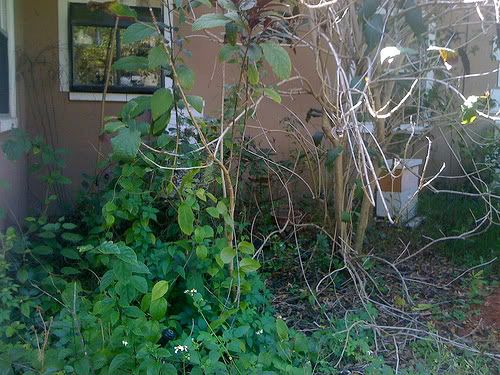Overgrown
It seems some new plant...well, not really new, more like 2-years-without-me-noticing, has managed to grow large enough to block out the sun from a vine which I had used to hide the hives. In addition, this has resulted in the nuc having a clear flight path without having to ascend first. I got a bee caught in my hair just walking out there earlier today.

That bleeding heart vine seems to have slowed it's growth since the air conditioning no longer drains on it. It was really there mostly to prevent street view of the hives, and to push the bees to fly up above anyone's head. I suppose it might be time to get something new in there, or do some trimming.
Earlier today, there were two Cardnals, a male and female, hanging around the azalia bushes near the hives. Every couple of seconds, they would dart into the flight path of the bees, land down in the leaves, and snap one of the insects between their beaks. Kinda interesting how a hive can attract something interesting to look at. Normally, they would be farther north by this time of year, but hey, with a year-round buffet, who would leave?

That bleeding heart vine seems to have slowed it's growth since the air conditioning no longer drains on it. It was really there mostly to prevent street view of the hives, and to push the bees to fly up above anyone's head. I suppose it might be time to get something new in there, or do some trimming.
Earlier today, there were two Cardnals, a male and female, hanging around the azalia bushes near the hives. Every couple of seconds, they would dart into the flight path of the bees, land down in the leaves, and snap one of the insects between their beaks. Kinda interesting how a hive can attract something interesting to look at. Normally, they would be farther north by this time of year, but hey, with a year-round buffet, who would leave?
0 Comments:
Post a Comment
<< Home